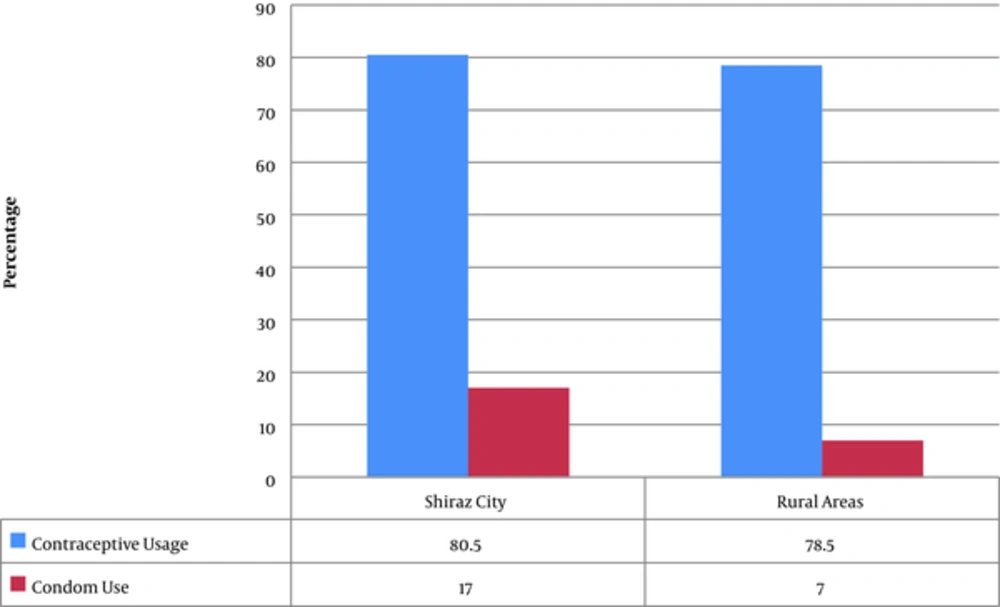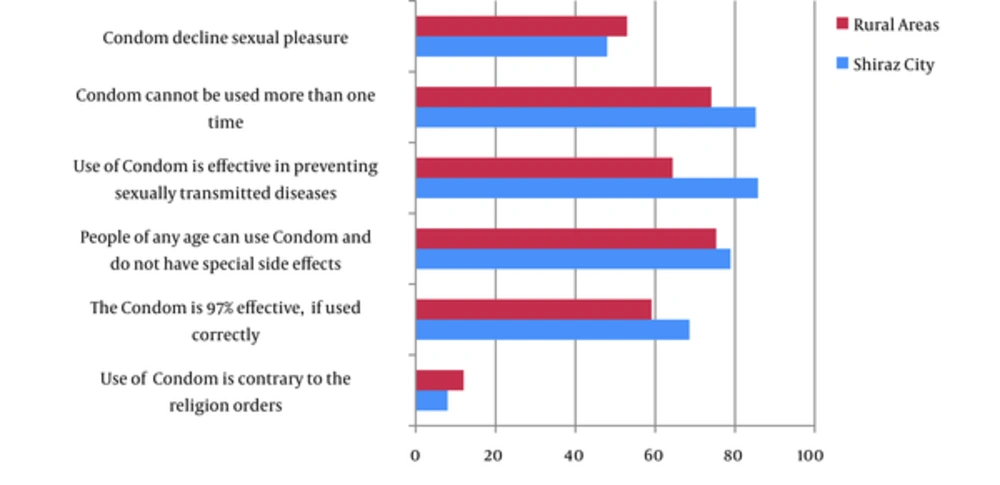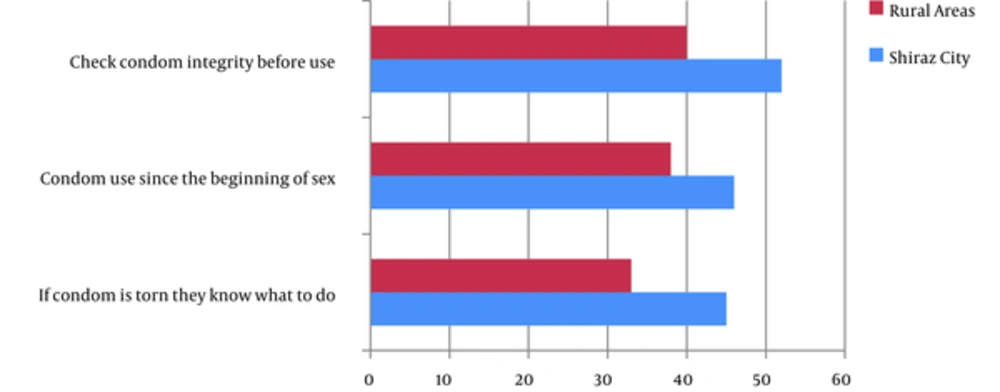1. Background
Obviously, condoms can play a vital role in decreasing the rate of unplanned pregnancies and sexually transmitted infections, including HIV/AIDS. This issue has great importance for Iran, as several studies have revealed that the rate of unintended pregnancies is relatively high in this country (1). Furthermore, during the past few years, the prevalence of HIV/AIDS in Iran has grown from a low status to a concentrated prevalence. Importantly, there is much concern that the pattern of HIV transmission in Iran may be changing towards a trend of increasing transmission from sexual intercourse; unprotected and unsafe activity is an important reason for the currently growing incidence of HIV infection in Iran (2). Statistically, unprotected sexual contact is the second route of HIV transmission in Iran (3).
Despite the benefits of condoms, it is not clear why the usage rate of condoms in Iran has dropped from 14% in 1976 to 9.3% in 2000, while Iran has the highest rate of contraceptive usage among Muslim countries, which is comparable with advanced countries, such as France and Germany (4). Although the rate of condom usage in Iran is higher than some Middle Eastern countries, such as Azerbaijan (3.6%), Qatar (3.8%), and Yemen (0.5%), yet in comparison with countries, such as Hong Kong SAR of China (50.1 %) and Japan (46.1%), it is very low (5). By focusing on female’s perception about condom and influencing factors, the findings of this research can help health planners improve the rate of condom usage and reduce problems, such as HIV/AIDS unmet need, unwanted pregnancies, and illegal abortion. Accordingly, the main goal of this study was to examine determinants of condom usage among couples of Shiraz county.
2. Methods
This research was a quantitative survey. It was conducted on married females in the reproductive age (i.e., 15 to 49 years), who were living in Shiraz county (including Shiraz city and rural areas). According to the Krejcie and Morgan’s formula (6), a sample size of 398 respondents was determined. Avoiding the sample attrition, 700 questionnaires were distributed (i.e. 400 and 300 questionnaires in Shiraz city and rural areas, respectively). However, only 626 questionnaires were included in the study, since 74 questionnaires were incomplete. In terms of sampling, representative samples were taken from 20 regions of Shiraz city and 5 rural districts through multi-cluster sampling. It should be mentioned that the married females, who were not living with their spouses 3 months prior to the data collection, were excluded from the study. The data collection tool was a questionnaire filled out by interviewers. The data was collected by a semi-closed questionnaire by 10 trained and experienced interviewers. The questionnaire consisted of questions regarding place of residence, marital age, educational level, and level of knowledge about contraceptives, particularly condom. Validity of the questionnaire was determined by health and social science experts. Furthermore, the reliability of the questionnaire was determined by a pilot study. The data was analyzed by the SPSS statistical software (version 20) both descriptively (i.e. frequency and percentage) and analytically (i.e. chi-square and logistic regression tests). In more details, the bivariate analysis was run before the logistic regression to compare the characteristics of condom users and non-users. The differences in the current use of contraceptives between the 2 groups were reported using the Pearson’s Chi-squared tests and two sample t-tests for the categorical and continuous variables, respectively. The Fisher’s exact test was performed when the number of the observations were less than 5 in any category of the nominal variables. In addition, the logistic regression was employed to test the models to predict condom usage.
3. Results
Figure 1 shows that although 80.5% of females in Shiraz city and 78.5% in rural areas used one or a mix of contraceptives, only 17% of respondents in Shiraz City and 7% of respondents in rural areas acknowledged that they used condoms.
Table 1 presents condom use according to some socioeconomic, cultural, demographic, and accessibility factors, which may affect condom usage. In addition, bivariate analysis was run to compare the characteristics between couples, who were actively using condoms and the nonusers before the Logistic Regression was done. The differences in the current use of condoms between the 2 groups were reported using Pearson’s chi-squared tests for categorical variables and two sample t-tests for continuous variables. If the number of observations were less than 5 in any category of the nominal variables, the Fisher’s exact test is performed.
| Variable | Condom Use | Other Methods and No Contraception Method | Chi2/t-tests | P Value |
|---|---|---|---|---|
| Birth Place of Husband | 7.55 | 0.004 | ||
| Urban | 18.3 | 81.7 | ||
| Rural | 10.1 | 89.9 | ||
| Residence Place | 5.71 | 0.011 | ||
| Urban | 17.0 | 87 | ||
| Rural | 7.0 | 93 | ||
| Age | ||||
| 15 - 19 | 18.8 | 81.2 | 8.45 | 0.016 |
| 20 - 24 | 20.9 | 71.9 | ||
| 25 - 29 | 17.7 | 82.3 | ||
| 30 - 34 | 11.1 | 88.9 | ||
| 35 - 39 | 11.4 | 88.6 | ||
| 40 - 44 | 8.2 | 89.8 | ||
| 45 - 49 | 2.0 | 98.0 | ||
| Spousal age difference, y | 0.593 | 0.843 | ||
| Below than 6 | 54.8 | 58.7 | ||
| 6 - 10 | 32.6 | 29.0 | ||
| 10+ | 12.6 | 12.2 | ||
| Family Income, $ US | 0.234 | 0.915 | ||
| Below than 300 | 13.7 | 16.6 | ||
| 301-600 | 60.0 | 60.0 | ||
| 600+ | 26.3 | 23.4 | ||
| Ethnicity | 6.814 | 0.078 | ||
| Fars | 16.9 | 83.1 | ||
| Tork | 13.6 | 86.4 | ||
| Lor | 11.1 | 88.9 | ||
| Other | 12.0 | 88.0 | ||
| Wife education level | ||||
| Illiterate | 9.5 | 7.9 | 7.48 | 0.112 |
| Elementary | 11.55 | 18.35 | ||
| Secondary | 35.8 | 32.4 | ||
| Tertiary | 31.6 | 23.0 | ||
| Husband education level | 7.43 | 0.115 | ||
| Illiterate | 5.9 | 5.8 | ||
| Elementary | 17.9 | 18.9 | ||
| Secondary | 33.2 | 32.6 | ||
| Tertiary | 25.1 | 23.7 | ||
| Actual number of birth | 1.98 | 0.370 | ||
| 0 | 17.4 | 21.1 | ||
| 1 - 2 | 51.9 | 53.7 | ||
| > 2 | 30.7 | 25.3 | ||
| Desired number of children | 5.34 | 0.067 | ||
| 0 | 27.8 | 28.2 | ||
| 1 - 2 | 44.4 | 42.6 | ||
| > 2 | 27.8 | 29.2 | ||
| Couple Agreement on Contraception Method | 5.52 | 0.006 | ||
| Yes | 48.4 | 51.6 | ||
| No | 26.0 | 54.0 | ||
| Distance from the first health center | 3.60 | 0.115 | ||
| Near | 77.9 | 71.8 | ||
| Relatively far | 22.1 | 25.2 | ||
| Far | 0.0 | 3.0 | ||
| Distance from the first pharmacy | 1.57 | 0.454 | ||
| Near | 65.3 | 59.3 | ||
| Relatively far | 13.9 | 33.9 | ||
| Far | 10.0 | 6.8 | ||
| Cost of condom | 0.590 | 0.845 | ||
| Cheap | 36.8 | 39.7 | ||
| Relatively Expensive | 56.8 | 52.7 | ||
| Expensive | 6.3 | 7.5 |
Comparison between Male Condom Users and Non-Users by Socioeconomic-Cultural and Accessibility Factors
Table 1 starts with a discussion on birth place. In fact, the birthplace (urban or rural) can affect the behavior of people and this influence could remain the same even if people migrate to another place. The results in Table 1 revealed that the percentage of condom usage among males, who were born in rural areas was 10.1%, while this rate for males born in urban areas was 18.3%, and this difference was significant (P < 0.05). In terms of residential background, as indicated, there was a significant difference between urban couples (17.0%) and rural couples (7.0%) in terms of condom usage (P < 0.05). Age is one of the most important factors that can affect contraceptive usage. Table 1 shows that the highest rate of male condom usage was related to females, who are from the age group of 20 to 24 (20.9%). Moreover, the rate of condom use decreases with increase of female’s age (P < 0.05).
Table 1 also reveals that spousal age difference can influence condom usage (P < 0.05). Moreover, the findings demonstrate that the highest rate of condom usage is related to couples with spousal age difference being below 6 years (54.8%), and the lowest rate of condom usage (12.6%) was related to couples with more than 10 years of age difference. With respect to family income, the findings demonstrated that in terms of condom usage, there was no difference between couples according to their income. However, the findings show that the highest rate of condom usage was related to couples with family income between $301 and $600. Furthermore, the findings about ethnicities, according to Table 1, indicate that although the highest percentage of condom use was related to Fars, this difference was not significant (P > 0.05).
According to the results, although there was no significant difference between couples with different educational level in terms of condom usage (P > 0.05), the lowest rate of condom use was related to illiterate couples. However, the rate of condom use among couples with tertiary education was lower than couples with secondary education level.
The results also revealed that difference between couples with different number of actual births and desired number of children in condom usage was not significant. However, the highest rate of condom usage was related to females, who had 1 to 2 actual births and desire to have 1 to 2 children. According to the results, regarding the couple’s agreement on the contraception method, the findings revealed that condom usage among couples, who had agreed on the use of a certain type of contraception was 48.8%, while the rate among couples, who did not agree on the contraceptive method was only 26.0% (P < 0.05).
Distance from centers providing condoms and financial cost of condoms was among factors that could influence condom usage. The findings revealed that there was no significant difference between couples in condom usage, according their distance from centers providing condoms (P > 0.5), yet descriptive results showed that the highest rate of male condom usage was among females, who perceived that both health centers and pharmacies were near. Regarding the cost, although there was no significant difference between couples in condom usage, according to their perception about cost of condoms (P > 0.05), the highest rate of male condom usage was among couples that believed that condoms were cheap.
3.1. Women’s Knowledge about Condom and Applying Method
Accordingly, Figure 2 summarizes and compares the knowledge and attitude of the females of Shiraz City and rural areas about Condoms, regardless of the fact that they are condom users or not. Figure 3 demonstrates the behavior of condom users regarding condom usage. One of the important factors that can influence contraceptive usage is religion (7) yet the findings show that less than 10% of females believe that condom use is contrary to religion order.
Moreover, the findings showed that a considerable percentage of females in Shiraz county, particularly in rural areas, did not have enough information about male condoms. Additionally, about 50% of both urban and rural females believed that condoms decreased their sexual pleasure (Figure 2).
In addition, only about 50% of condom users in Shiraz city and 40% of condom users in rural areas said that they checked condoms in terms of integrity. More importantly, less than 50% of females did not know what to do if condoms were torn during intercourse. Furthermore, less than 40% of condom users in Shiraz city and only about 45% of condom users in rural areas acknowledged that they did not use condoms since the beginning of their sexual relationship (Figure 3).
The results of logistic regression revealed that 6 variables had a significant influence on condom usage (Table 2). The findings of the study were analyzed in terms of odds ratio (OR) with 95% confidence intervals (CI’s). The maximum likelihood method was used to estimate the coefficients of the logistics regression models and all the variables showing a P value of less than 0.05 were considered statistically significant for the findings. Furthermore, there was no evidence that the observed and model-predicted values were different since the p value for the H-L test statistic was greater than 0.05, an indication of non-significance. This reveals that the model was well-fitted and its prediction was not significantly different from the observed values (8). In addition, Cox and Snell R2 and Nagelkerke R2generated explained systematic variance results ranging from 21.8% to 24.5%, respectively, for the first model.
| Predictors | B | S.E. | Wald | df | Sig | Exp (B) |
|---|---|---|---|---|---|---|
| Female’s Age | -0.454 | 0.034 | 5.46 | 1 | 0.019* | 0.924 |
| Spousal Age Difference | -0.238 | 0.061 | 2.15 | 1 | 0.023* | 0.871 |
| Influence of Condom on Sexual Pleasure | -0.359 | 0.152 | 3.19 | 1 | 0.018* | 1.431 |
| Husband’s Age | 0.020 | 0.027 | 0.556 | 1 | 0.456 | 1.020 |
| Education Level of Wife | 0.103 | 0.298 | 4.17 | 1 | 0.444 | 0.405 |
| Knowledge about Condom | 0.666 | 0.061 | 6.15 | 1 | 0.023* | 0.871 |
| Ethnicity | -0.713 | 0.445 | 2.56 | 1 | 0.110 | 0.713 |
| Education Level of Husband | 0.024 | 0.153 | 3.54 | 1 | 0.876 | 0.976 |
| Couple Agreement on Contraception Method | 0.233 | 0.162 | 2.55 | 1 | 0.000* | 0.367 |
| Number of Childbirths | 0.102 | 0.022 | 0.49 | 1 | 0.767 | 0.619 |
| Cost of Condom | 0.073 | 0.250 | 0.086 | 1 | 0.770 | 1.076 |
| Distance from Place Providing Condom | -0.001 | 0.066 | 0.000 | 1 | 0.986 | 0.999 |
| Residence Place (Living in Shiraz City) | 0.765 | 0.298 | 7.17 | 1 | 0.002* | 0.405 |
| Birth Place (Urban) | -0.529 | 0.322 | 2.695 | 1 | 0.101 | 0.589 |
| Constant | -1.081 | 1.29 | 0.69 | 1 | 0.405 | 0.339 |
Residence place was the strongest predictor of condom usage (B = 0.765, Wald = 7.17, P < 0.05). The next predictor was knowledge about condoms that positively influenced condom usage (B = 0.666, Wald = 6.15, P < 0.05). Wife’s age was another predictor that had a negative and significant relationship with condom usage (B = -0.454, Wald = 5.46, and P < 0.05). The next predictor of condom usage was the attitude of respondents about the influence of condom usage on sexual pleasure (B = -0.359, Wald = 3.19, and P < 0.05). Spousal age difference was the next predictor that negatively influenced condom usage (B = -0.238, Wald = 2.15, and P < 0.05). Couples agreement on the contraception method was another predictor of condom usage that had a positive relationship with condom usage (B = 0.233, Wald = 2.55, and P < 0.05).
4. Discussion
The findings of the present study revealed that although a considerable percentage of respondents used contraception methods, the rate of male condom usage, particularly in rural areas, was low. In more details, there was a significant difference between rural and urban females in terms of condom usage. It is believed that the fertility behavior of females that had migrated from rural areas and are currently living in urban areas, is under the influence of their residential backgrounds. This means that urban couples have higher tendency to use male condoms. Obviously, living in urban areas influences condom usage through different ways, such as higher access to family planning services and information sources. In other words, as Garenne (9) has suggested, the role of urbanization in fertility transition is complex. Rather than being directly related to fertility change, urbanization is a structural factor associated with other factors influencing contraceptive usage, such a rapid social change, higher levels of education, and household income. Results of another study conducted by Mostafavi et al. (10) in Iran, showed that the prevalence of male methods was higher in urban areas than rural. The findings also found that there was a strong positive relationship between the prevalence of male methods and the level of development (such as urbanization, literacy rates of males and females, and access to electricity, piped water, gas, and telephone). Similarly, a number of studies have revealed the difference of urban and rural areas in contraceptive usage (11,12).
Knowledge about condoms is another factor that showed a significant relationship with condom usage. Clearly, knowledge about family planning sources and methods is one of the key variables in contraceptive usage (13). It has been documented that couples may use non-reliable methods, such as natural methods, due to lack of knowledge about modern contraceptives (13,14). Age was another factor that has revealed a negative relationship with condom usage. In fact, younger females had higher knowledge compared to old cases as educational level of Iranian females was increased considerably in the recent decades. Furthermore, younger females showed greater interest in using temporary birth control methods in order to obtain their desired number of children. Another study also found that older adolescents had lower level of condom usage among both males and females (15). The findings also revealed that sexual pleasure was another factor that had a significant influence on condom usage; male condom usage was lower when females believed that condoms declined their sexual pleasure. Similarly, Fallahi (2) in their study on males living with HIV found that the most important reason for not using condoms was decreased sexual pleasure.
Spousal age difference was another predictor of condom usage. In total, spousal communication among couples with a lower spousal age difference was better since they understand each other better. Bongaarts (16) also believed that spousal age difference also played a large role in establishing a behavioral pathway and influenced inter-personal communication between spouses. This is in agreement with another study that found the rate of contraceptive usage, particularly modern contraceptives, decreased with increase in spousal age difference (17). Similarly, Asadi sarvestani (18) and Chintsanya (19) found that couple agreement on contraception method had a positive relationship with contraceptive usage, particularly modern contraception methods. Accordingly, as suggested by Bankole and Audam (20), the preferences of both partners are equally important in predicting a couple’s use of contraceptives.
The relationship between ethnicity and education level with condom usage was also examined. In terms of ethnicity, the findings revealed that there was no difference between ethnic groups in the Shiraz County regarding use of condoms. It can be said that all couples, regardless of their ethnic group, are exposed to information about condoms through several sources, such as formal education system, family planning service centers, and mass media. Furthermore, condoms are equally accessible to all females both at public (for free) and private health centers. Regarding education level, the results showed that there was no difference between females in condom usage, according to their education level. This is probably because of the fact that most females in Shiraz county had received formal education. Obviously, a formal education can have an impact on different aspects of family planning yet education and knowledge about contraceptive methods can also be transferred through other channels, such as media, family, and friends. Moreover, family planning in Iran has covered different groups of females regardless of their socioeconomic and cultural backgrounds (1,18). Couple’s perception about costs may prevent them to use contraceptives (21). However, the findings of this study did not find any relationship between the aforementioned factor and condom usage, because in the health-medical system of Iran, both health centers and pharmacies are distributed over cities and rural areas.
Overall, based on the current results, the rate of using male condoms in Shiraz county, particularly in rural areas, is low. It should be mentioned that this rate was found in a situation that couples could obtain condoms for free from public health centers. As a result, limitation in access to family planning services can decline the prevalence of condom usage. In more details, many couples, particularly from low economic category, may ignore condoms due to its cost. Moreover, despite the costs, in some rural areas, there is no pharmacy for providing condoms and this can be considered as another contributing factor in decline of condom usage, particularly among rural couples. Consequently, if new population policies do not pay enough attention to productive health and create limitation in access to family planning services, the rate of condom usage may be reduced. Resultantly, the rate of some problems, such as HIV/AIDS, unwanted pregnancy and abortion, may be increased.
Another issue that needs to be taken into consideration is that husbands play a vital role in productive health issues. However, the rate of condom usage has revealed that the participation of males, particularly rural males in family planning issues is relatively low. Accordingly, greater efforts are needed to influence the husband’s awareness of modern contraception methods, particularly condoms.
Finally, this research measured the role of husbands in condom usage, yet for more in-depth understanding, it would be better to conduct studies involving the couple, meaning both the wife and the husband. Also, the findings showed that a considerable percentage of females did not indicate agreement on the contraception method while couple’s agreement on these issues was one of the important factors influencing contraceptive usage, in particular condom usage. As a result, it is necessary to conduct new research in order to clarify factors affecting the couple’s agreement on contraceptive usage, particularly condom usage.
In conclusion, findings of this study revealed that condom usage is a complex issue, which is affected by a set of socioeconomic and cultural factors. In addition, with attention to problems, such as the rate of HIV/AIDS, unwanted pregnancies and illegal abortion, health planners should pay greater attention to factors influencing modern contraception methods, particularly condom usage.
4.1. Ethical Issues
Before conducting the pilot study and the main survey, the respondents were informed that the information provided by them would be treated confidentially and would only be employed in connection with this study. The respondents were told that they were not forced to take part in this survey. Moreover, other aspects of ethical issues, such as plagiarism, misconduct and double publication, were completely observed by the authors.



